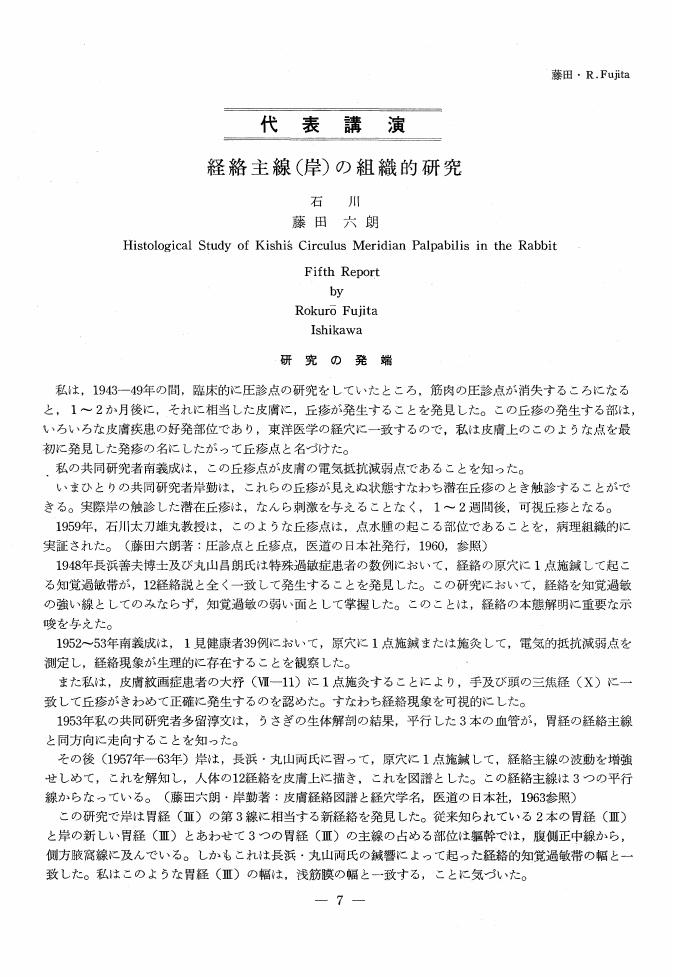1 0 0 0 OA 経絡の研究 (第7報)
- 著者
- 藤田 六朗 岸 勤
- 出版者
- The Japan Society for Oriental Medicine
- 雑誌
- 日本東洋醫學會誌 (ISSN:1884202X)
- 巻号頁・発行日
- vol.5, no.4, pp.12-18, 1955-03-31 (Released:2010-10-21)
Examination by means of the skin palpation technique developed by the author's co-worker Tsutomu Kishi yielded the following results. 1. A set of characteristic skin “Keiraku”(meridian) lines exists for each Keiraku. 2. As has been described by Sawada and Shirota, the “Bokokei”(VU) was found to coincide with the first, second, and third lines, and the T M 13 to be located at the seventh cervical vertebra. 3. Subcutaneous indurations belonging to “Yo-keiraku”(positive meridian) are seen as prominences, and those beloning to “In-keiraku”(negative meridian), as depressions, and those belonging to Keiraku of semi-positive, seminegative character included both types. 4. By studies on pulse diagnosis Fujita established the fact that the combination of intraand extra-vascular flow of the body fluids is helical in mode and came to the conclusion that the findings obtained by means of Kishis special technique could probably be analysed as a set of projections of mathematical curves braught about by some changes due to the heical motion of the body fluids. 5. Furthermore the cause of the undulatory change of the Keiraku is presumed to lie in the vibration of automatic movements of the twelve organs, among which the heart is of course the most important. Therefore the author considers that explanation of the undulatory character of Keiraku phenomena can be obtained by simultaneouly taking out the electric action current of each organ and measuring of its intensity in each of the Keiraku (1955, 19/II).
1 0 0 0 種々の組織の電気抵抗
- 著者
- 藤田 六朗
- 出版者
- 一般社団法人 日本東洋医学会
- 雑誌
- 日本東洋醫學會誌 (ISSN:04682548)
- 巻号頁・発行日
- vol.17, no.2, pp.61-62, 1966
Electrical resistance of dissected-mass (skin, muscle membrane and muscle together) in rabbit was examined by using the electro-dermometer.<BR>According to the decrease of the body fluid, electrical resistance of tissues gradually increases for 24, 48 and 72 hours after the dissection, but its increasing value is slight contrary to my expectation.<BR>The skin, of course, electrical highest resistance. But when the electric positive pole puts on the skin side and the negative on the subctaneous, and the electric current sents, the electric dermal points can be proved within the skin. And inversely when the positive on the subcutaneous side and the negative on the skin, it can also be proved the electric dermal points.<BR>The electro-dermal points of the skin show low-resistance, but, in spite of the decrease of the resistance as the applied time of the electrode goes on, remain slight resistance as that of muscle membrane. The electrical resistance between two endings of a blood-vessel shows retarded electric reaction, accompanied with a roar, whose value of the micrometer reaches highest in time. The electro-dermal point like this is often seen clinically and is, similar to the so-called thunder-point after Dr. K. Nanajo.<BR>But if the electric current sents from an ending of a nerve trunk to that of another, the rapid electro-reaction without a sound appears : the same as electrodermal point, so-called silent-point after Dr. K. Nanajo.<BR>In the case of a nerve trunk and two blood-vesels running parallel to it, appears the rapid electric reaction with a roar.<BR>In clinical practice the thunder-point proved mainly on red papulae and silent-one on white.<BR>From the fact above mentioned, I presume that the thunder-point in living body may originate from the changes of vascular-papulae and the silent-point from that of nerve papulae.
1 0 0 0 OA 経絡主線 (岸) の組織的研究
- 著者
- 藤田 六朗
- 出版者
- 公益社団法人 全日本鍼灸学会
- 雑誌
- 日本鍼灸治療学会誌 (ISSN:05461367)
- 巻号頁・発行日
- vol.15, no.1, pp.7-23, 1966-06-20 (Released:2011-05-30)
